#Morley Erwin
Text
Review: Iron Man Epic Collection 11: Duel of Iron

A bit sillier than I remember, but great nevertheless
My previous reviews have all been for Epics where most (if not all) of the issues are new to me, however, I'd already read all of the single issues in Duel of Iron prior to owning the Epic. So I think my perspective has altered slightly based on reading these for the second time.
I had forgotten (or had been so caught up in the good parts) how silly a lot of the villains are in Iron Man 11. In general, and, I say this as a massive Iron Man fan, Iron Man's rogues' gallery isn't great considering he's a founding Avenger and has been around since 1963. Even graded on a curve, many of these antagonists in these issues fall short. Foes like the Brothers Grimm and Vibro are basically goofy, one-off Silver Age villains, except that these comics are from the 80's not the 60's. There's also the cartoon-ish Zodiac crime organization, which tries to kill Iron Man in ways that feel like they'd be more at home in Looney Tunes (putting TNT in the van engine! Blowing up a bridge!) than the serious title that this was intended to be.
That said, the issues in this collection work, because the true conflict is actually James Rhodes and Tony Stark battling their own inner demons. Carrying on from the previous collection, James Rhodes is still serving as Iron Man, however, the armor seems to be giving him increasingly severe headaches which, in turn, make him more erratic. Meanwhile, Tony Stark, having lost literally everything in his battle with Obadiah Stane, is living on the streets as a homeless alcoholic. Tony's alcoholism reaches a turning point in the harrowing #182 (one of my favorite Iron Man issues), and he eventually attains sobriety. Yet when he joins Rhodey, Clytemnestra and Morley Erwin's fledgling tech startup company, it triggers Rhodey's sense of jealousy and his behavior becomes even more unpredictable and violent. Eventually, Tony is forced to don an older version of armor in order to stop his friend in the excellent #192 (another favorite of mine).
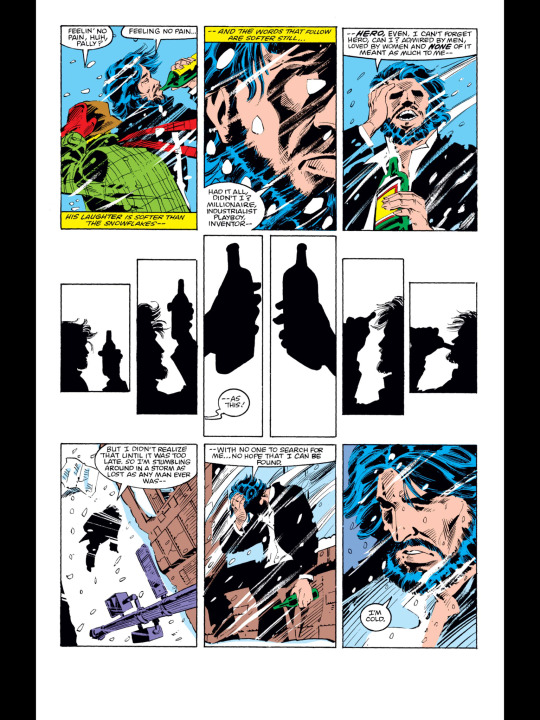
I love the way that O'Neil writes Tony and Rhodey. It's quite clever how the Iron Man armor represents something that gives them purpose and maybe even happiness, but both also believe that it's the source of their inner demons. The reader saw in this volume just how far he had fallen, and it makes sense that, since he thinks the armor exacerbated his personal problems, he would also be terrified to put it back on. When he finally does (albeit briefly) 10 issues later, the moment is that much more powerful. I’m less in love with the way that O’Neil resolved Rhodey’s headaches, but I did like that he sought out Henry Pym and Shaman of Alpha Flight to help him. I love when characters appear in other titles without it becoming a crossover. Those types of small interactions are what the Marvel Universe does best.

I knew penciler Luke McDonnell from the great Suicide Squad comics of the late 80's long before I read any of these issues. He's a very solid, no-frills storyteller. Given his clear, straightforward layouts and reliability (he even draws the Annuals in addition to the regular issues), I can see him being a favorite of Jim Shooter-era Marvel.
Duel of Iron is a great read, although I'm not sure how much you'd get from it if you hadn't read the previous volume (Iron Man: The Enemy Within). If they're read together, it makes one of the best character deconstructions ever done in comics, especially since O'Neil cleans up his own mess and puts a mentally stronger Tony back in the suit by the end of his run. We're still waiting for the conclusion of O'Neil's run with Iron Man 12, but would it also be too much for to ask for a reprint of Iron Man 10?
#marvel#marvel comics#marvel epic collection#epic collection#comics#comic review#iron man#tony stark#james rhodes#rhodey#obadiah stane#denny o'neil#luke mcdonnell#80s comics
1 note
·
View note
Text
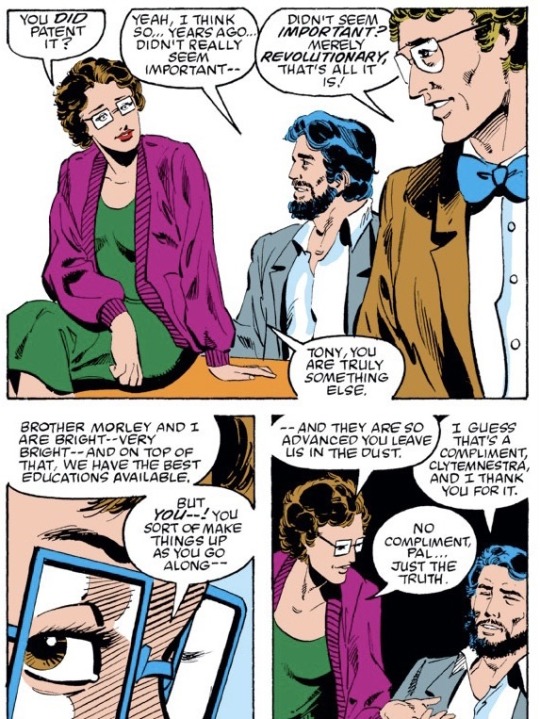

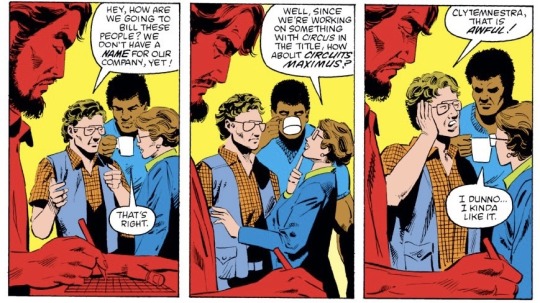

“tony stark is so egotistical” tony stark literally can’t take a compliment so jot that down
#i mean yes he HAS an ego and a complicated relationship w it#but that’s. All People lmao#tony stark#Clytemnestra Erwin#morley erwin#iron man
153 notes
·
View notes
Text
oh to be an engineer working for tony stark’s company that by chance sees him at his lowest and eventually becomes one of his close friends only to die a tragic death due to unforeseen circumstances that your older sibling will blame on tony for some reason
11 notes
·
View notes
Photo
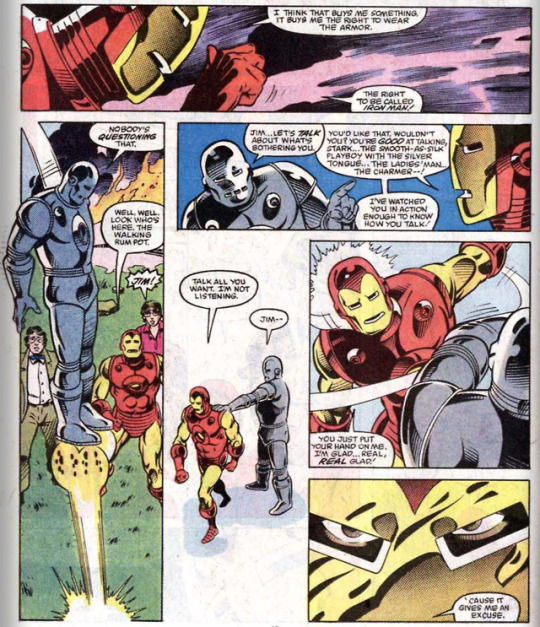
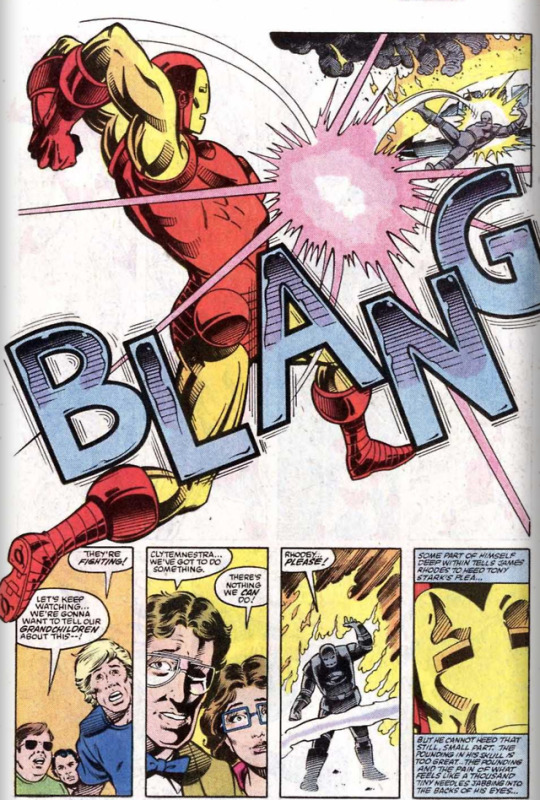
This is what I mean, not even 6 months ago James was all about bringing Tony onto the team, now he sees Tony in the suit and is like “oh yeah, I'm gonna point out my BFF’s terrible drinking problem first, then I’m gonna beat the shit out of him...” it really isn’t a good look.
5 notes
·
View notes
Photo
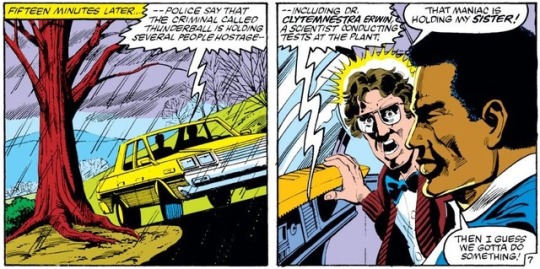
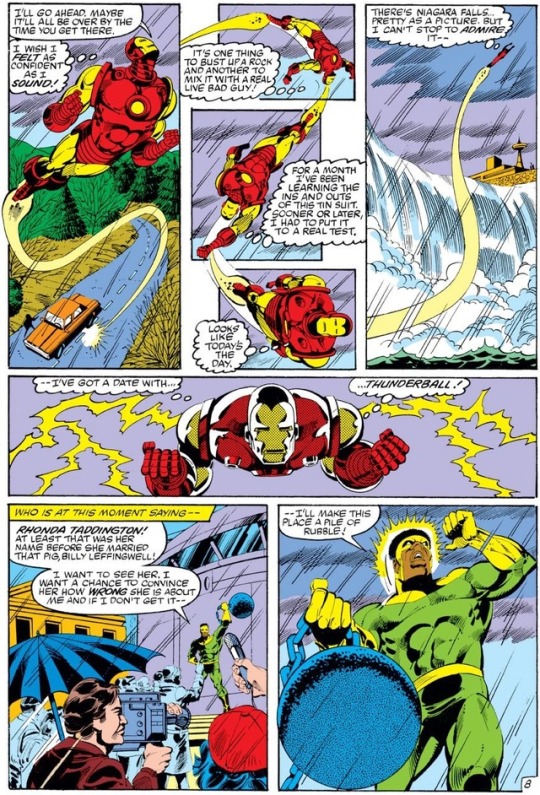

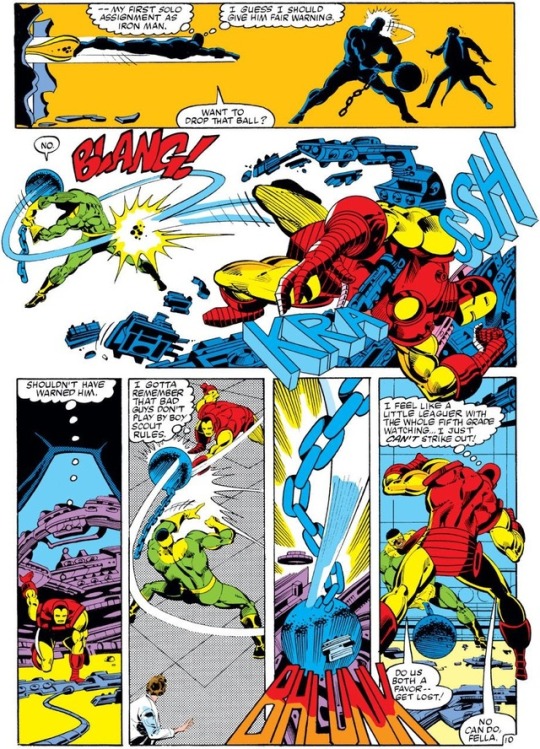
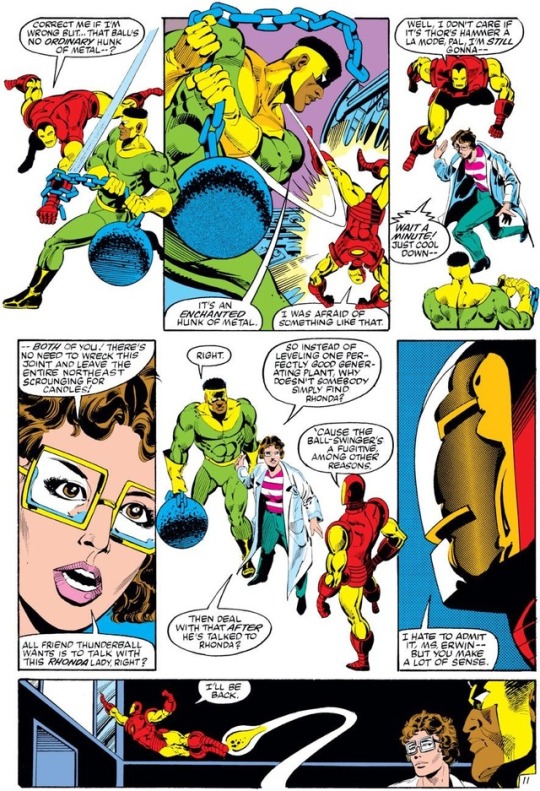
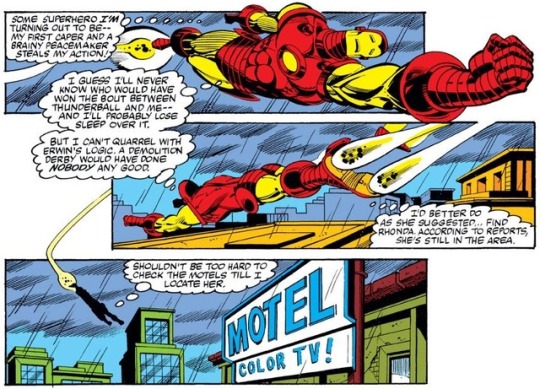
Iron Man vs. Thunderball.
[from Iron Man (1968) #171]
#Avengers#Iron Man#War Machine#Masters of Evil#Wrecking Crew#Thunderball#Clytemnestra Erwin#Morley Erwin
20 notes
·
View notes
Text
Mostly Mezzo Mondays: Cavalli, Handel (x3), and Mozart operas with Gauvin, Lemieux, Röschmann, et al.
Mostly Mezzo Mondays: a recurring (though not weekly) feature where, on Monday nights, I blog a list of the upcoming broadcasts that have caught my eye on World Concert Hall. My interests: baroque vocal music, art song recitals, and a list of favorite singers.
First off: the aforeblogged broadcast of Handel’s opera Lucio Cornelio Silla was quite a good listen, in my opinion, so I think it’s worth mentioning that it is still available online (warning: autoplay audio). I believe the listen on demand period for Ö1 is seven days, so this should stay up at least until Saturday. Very satisfying performances from Sonia Prina, Vivica Genaux, Roberta Invernizzi, Sunhae Im, et al.
Next up: a video livestream of Cavalli’s opera Il Giasone from the Grand Théâtre de Genève. The large cast is led by Valer Sabadus as Giasone (Jason) and Kristina Hammarström as Medea. Friday, February 3 on Arte.
We’ve now missed the Wiener Staatsoper livestream of Mozart’s Don Giovanni (sorry!) but you can catch a deferred audio broadcast and since it’ll be on Ö1, I expect it’ll remain available on demand for a week. The cast includes Simon Keenleyside in the title role, Erwin Schrott as Leporello, and Dorothea Röschmann as Donna Elvira. Saturday, February 4 on Ö1.
Also up for deferred broadcast on the 4th: Handel’s Orlando with Iestyn Davies, Erin Morley, Sophie Junker, Diana Moore, and Matthew Brook. Harry Bicket conducts the English Concert. Saturday, February 4 on Rai Radio 3.
Finally, to round out a star-studded Handelian week on the radio: a concert performance of Rodelinda from the Théâtre des Champs Elysées with Karina Gauvin, Marie-Nicole Lemieux, Romina Basso, David DQ Lee, Konstantin Wolf, and Juan Sancho. Maxim Emelyanychev conducts Il Pomo d’Oro. Sunday, February 5 on France Musique.
#opera tag#karina gauvin#marie-nicole lemieux#romina basso#david dq lee#konstatin wolf#juan sancho#handel#rodelinda#iestyn davies#erin morley#sophie junker#diana moore#matthew brook#orlando#simon keenleyside#erwin schrott#dorothea röschmann#mozart#don giovanni#kristina hammarström#valer sabadus#cavalli#il giasone#sonia prina#vivica genaux#roberta invernizzi#sunhae im#lucio cornelio silla#mostly mezzo mondays
10 notes
·
View notes
Photo
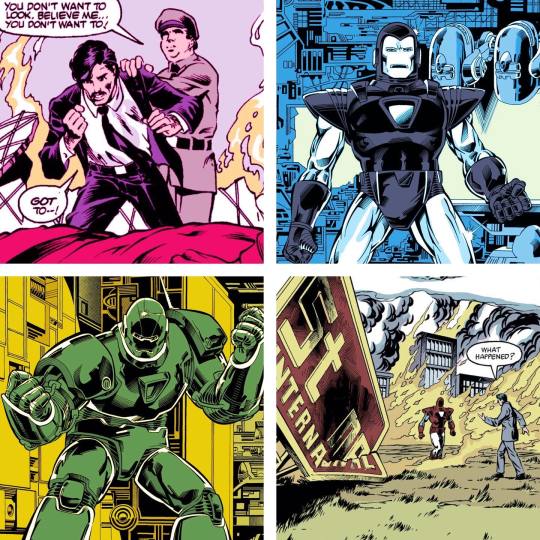
This week’s logo covers the events of Iron Man #200: the death of Morley Erwin; the return of Tony Stark as Iron Man, in the new Silver Centurion armor; Obidiah Stane as Iron Monger; and the death of Obidiah Stane! #marvel #cmro #mda https://instagr.am/p/CTNanC1PS5d/
0 notes
Text
Event announcement: UCI Law’s 10th Annual Supreme Court Term in Review
On Thursday, July 23, at 1:30 p.m. EDT, the University of California, Irvine’s School of Law will host a discussion of the biggest cases from the 2019-20 Supreme Court term. This year’s panel, moderated by Professor Rick Hasen of UCI Law, will feature Berkeley Law Dean Erwin Chemerinsky, Ariane de Vogue of CNN, UCI Law’s Rachel Moran, Florida State Law’s Michael Morley and Kate Shaw of ABC News and Cardozo Law.
Click here for more info and to register for the webinar.
The post Event announcement: UCI Law’s 10th Annual Supreme Court Term in Review appeared first on SCOTUSblog.
from Law https://www.scotusblog.com/2020/07/event-announcement-uci-laws-10th-annual-supreme-court-term-in-review/
via http://www.rssmix.com/
0 notes
Text
http://freecreditscore.home.blog/teton-diablo-avenue-las-vegas-nevada-credit-repair-888-630-5917/
http://freecreditscore.home.blog/teton-diablo-avenue-las-vegas-nevada-credit-repair-888-630-5917/
https://youtu.be/ldeaylZg69c
https://chicago60602.blogspot.com/p/euclid-pl-san-diego-ca-consumer-credit.html
https://medellinantioquiaabogados.blogspot.com/p/fletcher-hills-la-mesa-california.html
https://caldasantioquiacolombia.blogspot.com/p/ashford-lane-vancouver-washington.html
https://minnesota55104.blogspot.com/p/captiva-bluff-rd-s-jacksonville-fl.html
https://usa-credit-counseling.blogspot.com/p/custer-dr-san-jose-ca-consumer-credit.html
https://creditcounselingiowa.blogspot.com/p/bittner-st-rochester-new-york-credit.html
https://creditrepairunitedstates.blogspot.com/p/mayo-maryland-credit-repair-888-630-5917.html
https://consumerdebtcounseling158985170.wordpress.com/maysfield-texas-consumer-credit-counseling-service-888-551-1270/
https://unitedstatesconsumercreditcounseling.blogspot.com/p/maxeys-georgia-consumer-credit.html
https://www.facebook.com/Credit-Repair-Chazy-NY-call-1-888-630-5917-345302602259218/
https://postalmailbox.wordpress.com/hubbard-lake-michigan-virtual-mailbox-service/
https://flowersfresh.wordpress.com/iowa-flowers-fresh-same-day-delivery/
http://consumerreport.home.blog/erwin-north-carolina-credit-repair-888-630-5917/
http://consumerreport.home.blog/la-alameda-el-californiajon-california-credit-repair-888-630-5917/
http://fixbadcredit.home.blog/morley-st-san-diego-california-credit-repair-888-630-5917/
https://www.youtube.com/channel/UCwEzbAjqV2XUzedhtEr4qVA/videos
youtube
https://www.youtube.com/playlist?list=PL-B7IfFWtv9KxOuO7s_yuh_ZXlYhOBHR1
https://endlessvideo.com/watch?v=ldeaylZg69c
https://cse.google.com/cse?cx=003555290596869000553:l2dgwbwrqcs
https://cse.google.com/cse?cx=017718293001111184089:n6gblylpg14
from https://www.youtube.com/playlist?list=PL5LHhBfbi60zF7-mQii1n48UWZWFgsM2t
November 23, 2019 at 09:48AM
0 notes
Link
The idea behind Traeger Grills tongue-in-cheek “tastes like gas” line is quite simple - we all know that wood-fired BBQ tastes better, and suggesting that gas grilled “tastes like gas” reminds us of this. See, Traeger is the original and best wood-pellet grill available, and to tell everyone this the Traeger team collaborated with Nate Morley, Public Address, and Los Angeles-based GenPop, who has worked with big names like Marvel and Beyonce, to make this gassy-pun vision come to life.
This video is currently being processed. Please wait.
Traeger, CEO: Jeremy Andrus
Traeger VP, Brand Marketing: Hjalmar Hedman
Traeger, Creative Director: Sam Rodgers
Traeger EVP, Product, Sales and Marketing: Denny Bruce
Director: Nate Morley
Director: Patrick Brice
Producer: Rick Brown
Production Company: GenPop
Executive Producer: Nick Moceri
Creative Director: Nate Morley
Creative Director: Ben Conrad
Writer: Nate Morley
Director of Photography: Adam Frisch
Production Designer: Kris Starr Davila
Wardrobe Stylist: Ela Erwin
Editorial: Nomad Editing Co.
Editor: Jared Coller
Assistant Editor: Noah Phillips-Edwards
Post Producer: Tanner Gordon
United States
Household
pun
BBQ
-- via Adland
0 notes
Text




YOUR FRIENDS!! LOVE YOU!!!
29 notes
·
View notes
Photo

(via The Future of Design (and how to prepare for it, Part 2) - 99U)
For the second straight year, we asked 10 creatives to predict what is coming up in the world of design and how they will prepare for it. This year's installment includes designing for voice-controlled tech, holograms, and the rise of the hybrid designer.
By Madeleine Morley
Design is always changing, and wider changes are often spearheaded by design itself. Now with tech and the creative industry increasingly aligning, we’re on the precipice of a truly momentous period in the history of design, something unprecedented that is difficult to predict and prepare for. The way we describe the future in stories is rarely accurate: the optimistic or pessimistic sci-fi narratives of the past saw hover-cars, holograms, and teleportation as everyday items in the 21st century, most significantly failing to predict the Internet and its manifold repercussions. Any predictions that we do make right now will be in vain because of technology’s rapid developments:the devices that will drive even control our lives in a decades time hasn’t been invented or envisioned yet.
With quickly evolving tools, tumultuous shifts in the economy, the relentless growth of the gig and freelance lifestyle, and global networks, the working landscape for young designers is a tremendously uncertain one. There’s no model to follow: The known and well-trodden career path of previous generations is overgrown. What will this mean for the bedroom illustrator creating 3-D characters after school, or for the young freelancer setting up camp in a new coffee shop every day as she travels the world looking for new solutions, or for the promising UX grad poised for a career at a global branding agency?
It’s an uncertain time for design, but in its difficulty and complexity, it is an inspiring and crucial one: Those with the skills will help decide the way that innovations in tech not only look but function, too, and influence our daily lives.
Although we can’t predict the future, we can speak to those with experience who think about what’s in store. We asked each participant to give us their advice: What does their future of design look like? What will it do to the very idea of design. And how can we prepare for it?
Aesthetics will fall by the wayside as humanitarian considerations become of upmost importance.
“We are designers, but we are citizens first, and so we should use our skills to promote and envisage the society that we, as citizens, most want to be a part of. The most relevant questions we’re facing right now have to do with sustainability and the promotion of global equality and fairness. Designers should think about how their skills can be used for social good. When working for a client, for example, they can encourage ‘redesigns’ of the organization of the business so that it’s more sustainable and aware of its social, ecological, and political responsibilities. To give a product an eye-catching, cool surface is of course important, but it’ll be only 10 percent of the job.”
— Erwin K. Bauer, Designer and Founder, Buero Bauer, Vienna
Design will be for ears and not eyes.
“Voice-controlled tech will mean that there’s less of a need for interface design. Light and sound designers will find themselves with new roles, as will copywriters, and UX designers will need to define innovative user flows. Graphic designers and illustrators shouldn’t be scared, though: We’ll need character designs for digital assistants, first AR, then hopefully holographic ones. They’ll guide us through our calendars or do digital errands, like liking our boss’s Facebook posts.”
— Laszlito Kovacs, Creative Director, WeTransfer, Amsterdam
A broad skill set will be an imperative for getting noticed.
“There’s no longer such a thing as a typical design or branding job. Gone are the days when one simple or trademarked process could be used across multiple, similar client projects. Now, every single project that crosses our path brings new challenges with it. At the beginning of a job we’re often unable to fathom what the final deliverables will even look like as the landscape shifts around us throughout the design process. We’re always getting our heads around designing for the latest technology, methodology, application, media, or format. It’s a fascinating time to be a designer. There will always be space for experts, for those who specialize in the things they are really, really good at, but for others there is the need to diversify. With the democratization of design, ‘every man and his dog’ has a belief in their own design ability. To combat this, designers need to have an array of skills and talents they can draw upon, a range that makes them both fascinating individuals and truly impressive creatives.”
— Katie Taylor, Executive Creative, Director, Brand Union, Berlin
The rise of the independent practitioner will continue rejecting, countering, and perhaps even threatening the traditional agency model.
“Individual practitioners and independent studios have been building and emerging steadily for many years now. We practice within that space; one could define this as a ‘new design industry’ or a ‘counter-design industry.’ The way we work is becoming more sustainable on an economic level; the individual practitioner is becoming a larger part of the cultural landscape and is working on large-scale projects with a significant scope–through conversation and synergy rather than service-based structures. It changes something when you counter the preconceived notion of ‘design industry.’
From our perspective, this space will steadily continue to grow. Entrepreneurialism is key to this kind of independence, whether that’s through designing and selling tools, pieces of code, typefaces, or by forming publishing platforms. We have to train young designers to understand what they are about to emerge into: The independent space is often thought as ‘counterculture,’ but it’s not anymore and we should take advantage of that. Education will be important not just for clarifying this change, but helping students develop new skills that will be useful to exploit it.”
— Rory McGrath, Cofounder, OK-RM, London
Context will be key.
“Working as an illustrator paired with the fact I have a never-ending stream of visuals in front of me is both inspiring and mind-numbing. It’s important to understand the history of where images come from and how they came to be, rather than just mimicking superficial trends. It’s also important to give credit when it’s due. The most original and successful image makers will be the ones who acknowledge and appreciate the tools utilized to share work, but they will also look beyond what’s on the screen for inspiration.”
— Ping Zhu, Illustrator, New York City
Logo design of the future? There will be no such thing.
“A logo is a clunky piece of communication, unable to adapt to changing environments. It’s absurd to teach logo design to future generations when the world is in constant motion and communication is utterly context-related. It’s like a market crier shouting the same message over and over again instead of listening to customers and adapting to what they say. Don’t get me wrong; we still need logos, but it’s nonsense to start the design process by drawing a static one. The logo is just one image generated by the entire visual system. If we learn how to develop flexible visual systems, the application of the visual identity will be most efficient and effective.”
— Martin Lorenz, Creative Director, Two Points, Hamburg, Germany
The most celebrated brands will use design as a tool to drive positive change.
“We have seen a huge shift in consumer expectations of brands in recent years: They are more skeptical of traditional powers like governments and politicians, and are looking at businesses to be the drivers of positive change. This means that it won’t matter if you can design the most beautiful logo or craft the most intricate typography; it will only matter if you can design to strategically unleash and express a brand’s core truth in a way that connects with consumers on a deeper level. You’ll need to showcase that a brand stands for something more than selling its product. One day designers and marketers will be one and the same–after all, they say the MFA is the new MBA.”
— Julie Peters, Strategy Director, Pearlfisher, New York City
We won’t tell stories; we’ll live them.
“Attention is our most valuable commodity in a fast-paced, digitally noisy world. This is where VR will come in. With 360-video storytelling, you get some level of immersion, but it’s limited, as a user can’t interact with the environment. Story-living, on the other hand, applies to a VRE where ‘presence’–the real magic of VR–is at its most powerful. Within a VRE, you’re fully immersed and the viewer is completely attentive. Unlike traditional film-making where the director has complete control over what the audience gets to see, VR allows viewers to make their own decisions about what they focus on in the scene.
This is a potential problem that no one quite has the answer to yet: How do you keep the level of freedom and interaction that VR allows the viewer while making sure they don’t miss any of the key elements of your piece? There are several options open to the director to ensure the audience’s attention can be focused when necessary: lighting and sound cues, changing the focal point of an object or character on-screen, Even verbal/action cues can be a powerful tool.”
— Sol Rogers, CEO and Founder, Rewind St. Albans, U.K.
Drop your pencils, scrap your notepads, and install your 3-D modeling tools: Innovation in illustration will exist in not two but three dimensions.
“3-D tools are cheap or free for now, and the technical skills of 3-D modeling are becoming a standard part of the designer/illustrator tool kit, not just a lucrative specialization. Traditionally, a lot of 3-D design has looked the same: sleek, realistic, and inspired by trends in industrial design. Given the fact that creatives are becoming more versed in the technical skills for 3-D work, we’ll start to see more and more artists using 3-D modeling not just for mock-up but for artistic expression. There still aren’t that many 3-D illustrators relative to the entire field of illustration, and so there are huge, wide-open areas of the landscape that any illustrator could claim as their own. 3-D illustration might be on the edge of a huge explosion in terms of the variety of styles and points of view that will be explored. It’s a good time to get in on it.”
— Julian Glander, Illustrator, New York City
Whittle a brush, set up an inkwell, and then take a trip to the library: Those with a deep-rooted knowledge of a craft will be the ones whose work truly endures.
“The world of lettering has, once and for all, been struck by the importance of the hand. This is of course a response to the perfectionism of the computer; graphic design, and type design, achieved a digital sleekness and mathematical precision over the last two decades that a hand never could. ‘Handmade design’ (or that which noticeably was created by a hand-drawn process, or that evidently was made by hand before the piece was digitalized) was not the preferred option for most graphic designers at the end of the 20th century. Nowadays, though, the ‘handmade’ can be spotted everywhere, from printed media to an app interface, and in a world of increasing digitalization, that’s not going to go away anytime soon.
Type design is no exception to the newfound love of the handmade, and of course the ‘trendy’ handmade look of letters was quickly capitalized on by the market. “Responding to a renewed interest in the handmade, the industry created digital versions of hand-drawn processes. With an affordable price tag, this has of course drawn in a huge amount of independent designers and young studios: a turning point for “handmade design,” and one of the reasons that it could become commercially popular and widespread. But because of its popularity, the relevance of the quality of letterforms is being forgotten: In the pursuit of that shaky stroke or that messy baseline that imitates handwriting, the art of calligraphy falls by the wayside. Popularization–and increase in demand—in this case is to the detriment of quality. Only those who chase perfection in their designs and make technology serve their process will be the ones whose work humbly and effortlessly stand outs and is remembered.”
— Yani Arabena and Guille Vizzari, Calligraphers, Buenos Aires, Argentina
Adapt, adopt, experiment: A broad skill set will not only get you noticed, it’ll be imperative for success.
“We’ve noticed in recent years that brands need to keep churning out content in order to engage with their targeted audiences, and that they’re far more focused on digital campaigns as a result. This gives us, as designers, room to experiment with different kinds of execution techniques, to try things out, and to be more playful. The downside is that we churn out content so fast to the detriment of quality, and there’s often significant downscaling when it comes to budget. As a result, it’s unsurprising that we’re seeing more hybrid designers: If you have less of a budget, it’s perhaps better if you can illustrate instead of having to hire an additional hand. Gone are the days where a designer would just be doing one specific role. Our advice for the future is that an illustrator or designer should be able to adapt; they should be able to learn new tools and skills to survive the ever-changing landscape of the industry.”
—Fizah Rahim and Rezaliando, Motion Designers, Machine East, Singapore
The most well-known illustrators will be the ones sketching from their beds.
“The resources to create digital artwork have become totally accessible by all, which has seen digital, online communities grow massively, especially 3-D, in the past five years that I’ve been working within the industry. In addition to this accessibility, the nature of sharing work online (namely Instagram) has become such a phenomenon that bedroom artists are being born, and it provides the opportunity and chance for just about anyone to be noticed. The downside to this is that an already saturated industry becomes even more saturated, and imagery becomes watered down. Emerging illustrators and designers are halfway between being in the best and the worst time to start out. Social media has become the ultimate platform to be seen and heard, but the true test is trying to shine out from the masses amongst the melting pot of digital imagery.”
— Rose Pilkington, 3-D illustrator, London
The sharpest web designs will be the ones bursting bubbles.
“We are the first generation to live with the iPhone, and the impact of that little machine on our lives is fundamental. It’s similar to how people were dealing with drugs in the ’60s or ’70s: It’s an exciting, chaotic time, and social conventions still need to be learned. Most people access the web and go straight to Facebook, Google, or another big tech company. The promise of global cultural exchange that the web first espoused has ended up a false one; instead it’s self-indulgent and blinding. Our favorite web designs in the future will be the ones revealing the dangerous patterns, bringing back the old optimism, and making people smile.”
— Luna Maurer and Roel Wouters, IxD Designers and Founders, Studio Moniker, Amsterdam
[Entire post — click on the title link to read it at 99U.]
***
We’re glad that overall, the U.S. economy has significantly improved in the past few years, and that “new Silicon Valleys,” or place-specific innovation centers, are growing all over the world, at least in terms of innovation and the development of creative economy ecosystems — and we would love to visit them all! We all learn best by exchanging ideas across cultures and industries. We fully support complete diversity in the workplace, and overcoming the inequality challenges that are still too prevalent in our world.
Now, entrepreneurs, intrapreneurs, and organizational leaders from other cities and countries who are visiting the San Francisco Bay Area can have access to Silicon Valley companies to learn from their cultures, hiring, leadership and innovation methods. Come join us for a dynamic, unforgettable, and very enjoyable Innovation Tour in San Francisco, Silicon Valley, the East Bay (Emeryville, Oakland, Berkeley, and more), in the Wine Country, or on the beautiful, rural Northern California seacoast in Mendocino County, including Fort Bragg, California, where we have worked on business, arts and tourism projects.
At Creative Sage™, we design high impact, customized creativity, innovation, and leadership programs, and we are now offering related tours, events and workshops in wonderful urban and rural settings that will spark your imagination — and your team’s — to come up with brilliant ideas and plan how to implement new innovations in services, products, your organization’s business model, operations, or in any other area.
We use the latest in value-tested creativity and innovation techniques and processes; and we select world-class facilitators and partners to help your organization gain lasting value from your experience working — and playing — with us. Creativity and innovation processes could include design thinking, business model canvas, arts-based, interactive creativity activities, lateral thinking, gamification, or other proven methods.
We also work on workplace culture issues, leadership challenges, handling transitions, and building resilience in organizations and individual clients. You’ll be able to see first-hand how Silicon Valley companies create a culture of creativity and innovation, and you’ll be able to talk with their leaders. We’ll arrange a customized tour for you that addresses your organization’s issues.
We can design additional customized programs and tours for individuals, families, work teams, university students and faculty, including those in undergraduate or graduate entrepreneurship or MBA programs, and other special interest groups, such as the charitable tourism activities.
Join our email list and visit our web site, or call: (510) 845-5510 for more information.
You’ll take away essential, valuable insights that you could not achieve in any other way, while enjoying the experience of a lifetime!
***
0 notes
Photo
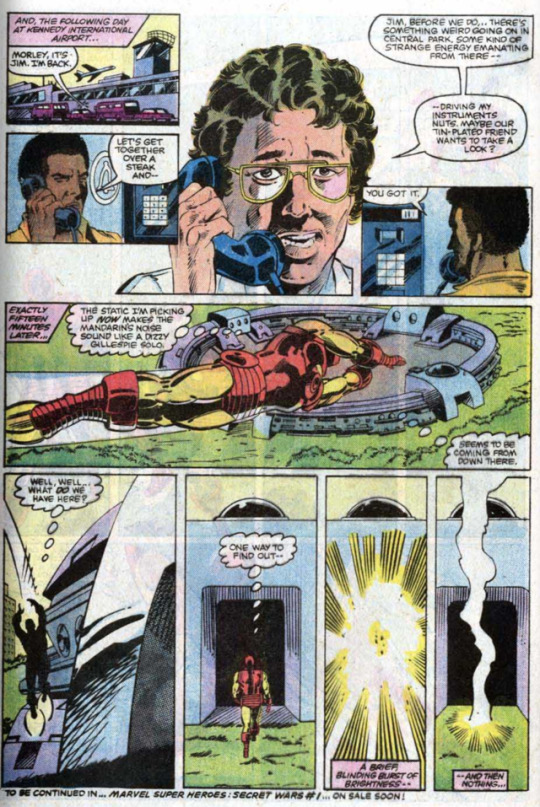
This, however... is really important. I’ll talk about this a lot more later on, but the gist is, leading up to Secret Wars, Jim Shooter REALLY wanted to let everyone know the book was coming, so he made all of the main books with participating characters put in a scene where the heroes stop by Central Park, only to get zapped up by this machine.
8 notes
·
View notes
Photo


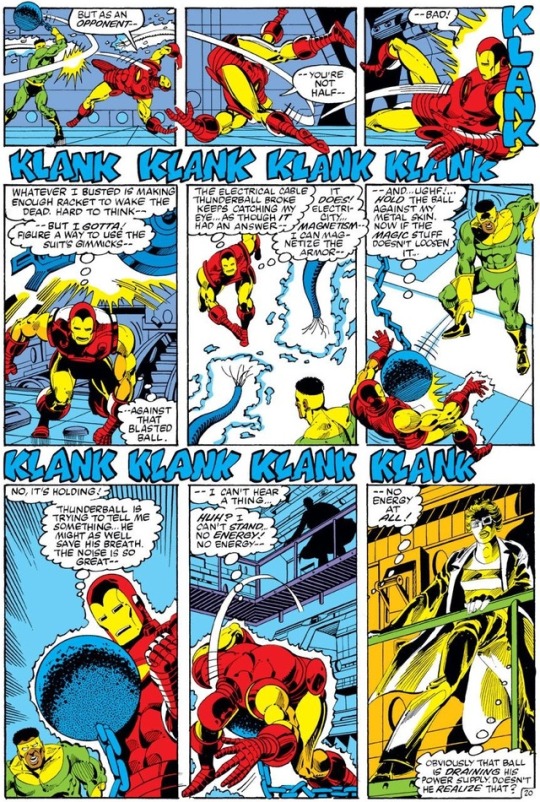
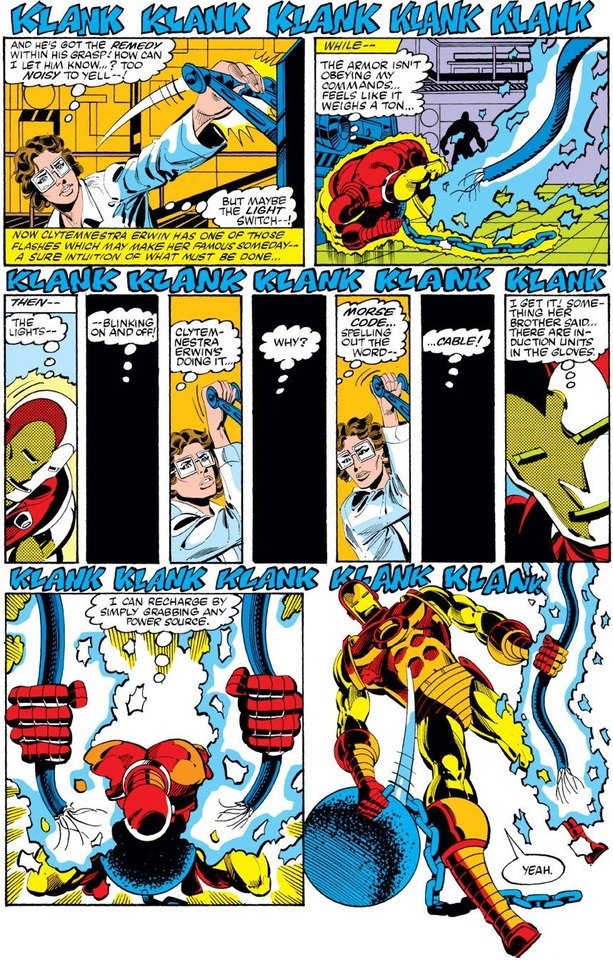
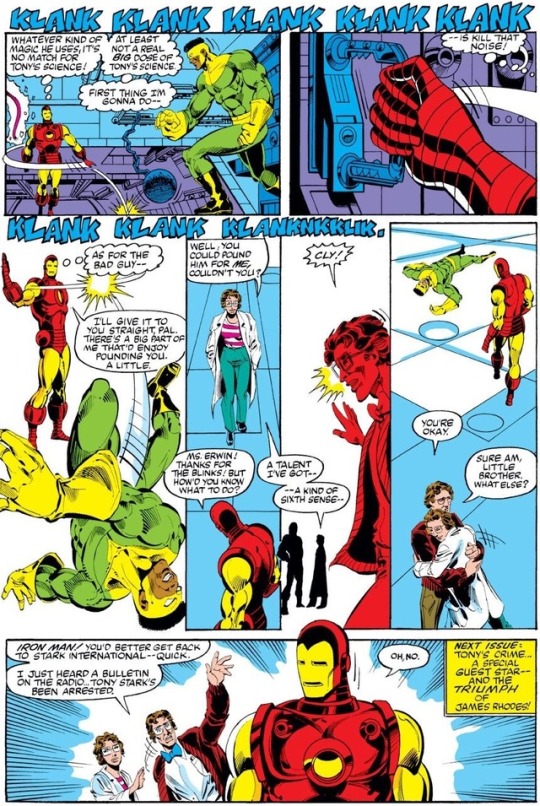
Iron Man vs. Thunderball.
[from Iron Man (1968) #171]
#Avengers#Iron Man#War Machine#Masters of Evil#Wrecking Crew#Thunderball#Clytemnestra Erwin#Morley Erwin
18 notes
·
View notes
Text
11 Double Slit Experiment Explained 22Aug17
Introduction
If photons are directed at a screen with a hole or slit in it, an interference pattern can be produced and seen on a detection screen. If the intensity of the photons is so low that they can be thought of as travelling one at a time, and the detection screen is replaced by a photographic film, the same interference pattern builds up over time. If we detect which slit the photons have gone through the interference pattern disappears.
I’ll discuss the slit version of this experiment using the phot model for a photon. Then I’ll discuss the double slit experiment.
Explanation in terms of Phots
The phot explanation is simple. Since the phot has spatial extent sideways, it interacts with the whole slit. It is absorbed and reborn in one edge of the slit or the other. It sets off again, again in the form of a flat electromagnetic “frozen pizza”, travelling face first, with a well defined path and a definite central line of travel. But something special has happened to it while it was being reborn. A part of the original phot interacted with the other side of the slit. This energy then became part of the new child phot, but it a special way. It reunited with the rest of the child phot in discrete steps related to the energy level of the phot (which is manifested in the frequency of the electromagnetic disturbance created when a phot is absorbed). It forces a synchronisation with the rest of the phot. The result is that the recombined child phot has to head off at a discrete set of directions. Each direction corresponds to one of the synchronisation modes. The child phots then hit the s detection screen and build up the interference pattern.
The traditional explanation of radiating spherical wave fronts with peaks and troughs reinforcing works, but if you think about it closely, it does not stand up to even elementary skeptical scrutiny.
Now let us move on to the famous/notorious double slit experiment. This works best with monochromatic light. Note that the experiment can also be done with electrons, or even atoms and larger particles, but that is another story.
Note that the two slits have to be a distance apart that is comparable to “wavelength” of the light. But phots do not have a wavelength. In phot language the first sentence in this paragraph should be replaced by a sentence that says “make sure that every phot can splat into both slits”.
The explanation is very similar to the single slit explanation. Every individual phot interacts with both slits. It is reborn in one slit or the other but with a specialized contribution from the other slit which forces the reborn “child” phot to head off in a discrete set of paths that builds up into the resultant interference pattern.
Underneath the main interference pattern it might be possible to discern two faint diffraction patterns arising from each of the slits individually.
The enduring perplexity of double slit experiments comes from clinging to the wrong mental model of a photon as a discrete particle that can only go through one slit or the other. This also leads some teachers to say that a photon cannot interfere with itself.
A phot is a discrete object, but it can go through both slits and it can and does interfere with itself. Once you admit this interpretation the experiments become a lot less perplexing. The magician’s trick is no longer so mysterious and magical (see my very first blog in this series).
It should also be now apparent that trying to determine which slit the light has gone through is a misguided exercise. It is the wrong question.
Conceptually a valid question is “which slit is the principle origin of the child phot and which slit provided the steering component”, but answering this will be tricky. You cannot observe a phot in flight. You can only observe it once and to observe it is to destroy it. Nevertheless it might be fun to experiment with one of the slits and not the other to see what happens. For example, heat up one of the slits, or influence it with strong electric or magnetic fields.
I think Erwin Schrodinger got close to an interpretation of the double slit exercise which is similar to the one provided here using the phot model. Schrodinger replaced the photon by a probability wave function and allowed some of the probability to percolate through one slit and the rest through the other. This allows photons to interfere with each other. The whole approach works well mathematically, but to be honest, I think the interpretation adds a lot of unnecessary mystery to quantum physics and eventually causes problems.
Schrodinger (added and abetted by Einstein) spent a lot of time worrying about the fate of a cat exposed to quantum fluctuations and the Complementarity Principle school of thought (see Schrodinger’s cat thought experiment). According to the standard quantum theory approach, the act of observing the cat resolved whether it was alive or not. Einstein is reported to have said “God does not play dice”.
There are a lot of versions of the double slit experiment and it will be interesting to apply the phot approach to all of them. However, for the sake of any readers, and because I have some other and equally interesting destinations in mind, I will move on to discuss the Michelson-Morley experiment in terms of phots and then I want to discuss general relativity, the physics of spiral galaxies, the origins of inertia and the big bang theory. I hope to give a description of double slit experiments using electrons and atoms in some later blogs.
Conclusion
The phot model seems to offer a simple explanation for Young’s double slit experiment on light. I will be surprised if no-one has come up with explanation like this already, but I have not seen anything like it anywhere. If the phot model and explanation happens to be original and viable, then I will wonder why it has taken so long. In any case, I hope others will think skeptically about the conventional, inherently self contradictory wave-particle model of light and also try to come up with something better.
0 notes
Photo
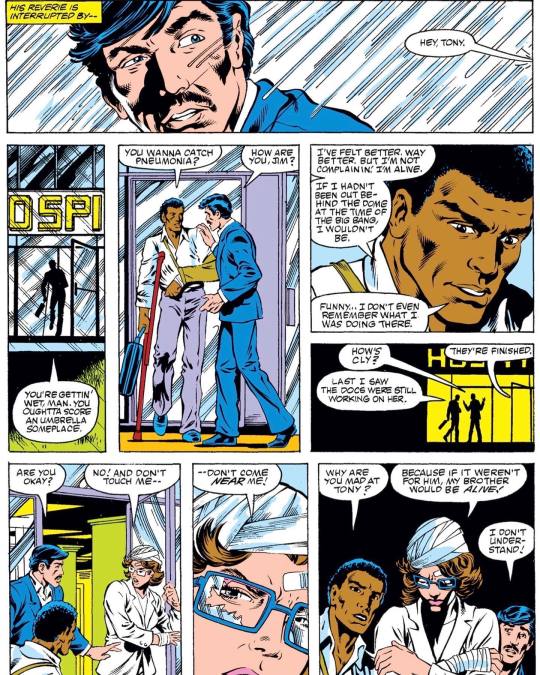
It wasn’t Rhodey who was killed in the explosion—it was Morley Erwin. And it’s possible that Morley’s sister will never forgive Tony for not stopping Stane when he had the chance. #marvel #ironman https://instagr.am/p/CTIrJLKvxLr/
0 notes